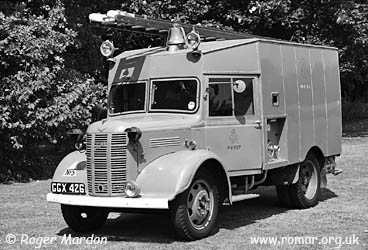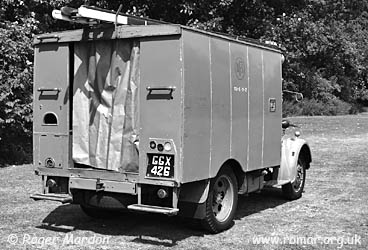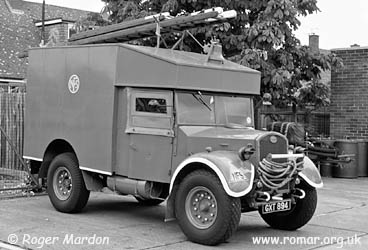Fire service historian and author














POST-WAR USE
The wartime towing vehicle was ideal for towing a trailer pump and transporting a
crew and equipment to pour vast quantities of water onto wartime fires, but it was
not designed for attending peace-time incidents. After the war many small fire stations
had to rely on the towing vehicle and trailer pump and the deficiencies soon became
apparent. One of the first remedies was proposed by the Ministry of Works in December
1945 when plans were issued enabling the towing vehicle to be converted into a hose-reel
tender. The modification involved installing a Winn PTO-driven hose-reel pump and
a 60-gallon water tank at the front of the rear compartment although, in practice,
it seems that a 120-gallon tank was often fitted. A 180 ft hose-reel was mounted
above the tank and the hose-reel tubing could be paid out through roller-guided ports
on either side of the body. The pump control was installed behind the nearside front
door and incorporated a five-way valve for:
(1) tank – pump – reel operation, where water was fed by gravity from the tank to
the pump and delivered under pressure to the hose-reel,
(2) hydrant – reel operation, where hydrant pressure was sufficient to feed the hose-reel
direct,
(3) hydrant – pump – reel operation, where hydrant pressure was low and water had
to be pumped to the hose-reel for delivery under pressure,
(4) hydrant – tank, to refill the tank from the hydrant.
The fifth valve position was 'off'.
This modification made the towing vehicle and trailer pump reasonably self sufficient,
and enabled it to stand a chance of competing with pre-war regular fire engines which
generally had only a 40- or 60-gallon first-aid system and hose-reel for rapid attack
and extinguishing small fires. The conversion created a physical separation between
the driving cab and the rear crew and equipment area.
Modifications proposed in August 1946 comprised the fitting of a fog lamp, two roof-mounted
spotlights, and cab, locker and load space lights.
Another, less common, post-war improvement involved the installation of a front-mounted
pump, usually a Barton 300gpm unit but at least one ATV survives with a Beresford
pump installed ahead of the radiator and grille.
Many towing vehicles were transferred to the 146 local authority fire brigades established
in England, Scotland and Wales after the war by the Fire Services Act 1947. In 1949
there were 1,038 towing vehicles in service in England & Wales and, according to
HM Chief Inspector of Fire Services, most of these had been modified by the addition
of a 120-gallon tank and hose-reel equipment. The modifications noted above were
not necessarily undertaken before transfer, if at all, and some vehicles doubtless
ended their lives, or went into preservation, without seeing any improvements. Austin
K2 appliances also commonly saw service as salvage tenders or foam tenders and many
were converted for use as mobile workshops, while others were used as general purpose
vans.
The AFS, as part of the National Fire Service, disappeared when fire brigades were
returned to local authority control in 1948 but it was promptly reconstituted in
response to the threat of nuclear war. The post-war AFS inherited vehicles from
the NFS and nearly 80 Austin K2 vehicles are listed in The Green Machine by Barry
R. Hollis and John C. Thompson.
The durability of the Austin K2 ATV is demonstrated by its survival in use with some
fire brigades into the 1970s.
WARTIME USE
In the early stages of World War 2, an assortment of cars, taxis and light commercials
was pressed into service with the Auxiliary Fire Service (AFS) to tow the 20,000
trailer pumps which it was estimated would be needed to keep the fire service adequately
equipped for war. This proved to be a false economy because hire charges and repair
bills swallowed up the savings expected from not buying purpose-built vehicles in
the first place. During an air raid on Manchester in December 1940 so many of the
city's make-shift towing vehicles were out of action or under repair that trailer
pumps had to be pushed to fires by their crews. Against this background, in 1941
the Government approved the purchase of 2,000 two-ton vans for use as towing vehicles,
each with internal seating for the crew and stowage for hose and small gear. Let
it be said now that, although widely known now as the auxiliary towing vehicle, or
ATV, there is no evidence to suggest the appliance was so called until after the
war.
Production started in 1941 and continued apace until 1943. Few, if any, of the 5,750
towing vehicles believed to have been finally built would have been operational in
time for the large scale bombing of London and other major cities during the Blitz
of 1940/41. When over 1,600 local authority fire brigades of England, Scotland and
Wales were nationalised on 18 August 1941 under the National Fire Service (NFS),
the AFS and its towing vehicles were absorbed into the new national body.

Most of the new vehicles were built on the short wheelbase Austin K2 2-ton chassis
but some were built on the Fordson WOT2 15-cwt chassis. Both were rear-wheel drive
and the Austin was powered by a 6-cylinder, 3460cc petrol engine whilst the Fordson
was fitted with a V8 3261cc petrol engine. It is believed that a few towing vehicles
were also produced on the Guy Ant 15-cwt chassis but none are known to survive. All
three vehicles were about the same size and the cautious weight designation of the
Fordson and the Guy appears to reflect their primary use as military vehicles. The
bodywork was steel with a specially strengthened roof to provide protection from
shrapnel and flying debris. The driver and officer-in-charge sat up front while
the rest of the crew sat in the back on what was described as padded seating accommodation,
this actually comprising a cushion over the equipment lockers down each side of the
rear compartment. There was no separation between the driver's cab and the rear
crew area and it was possible to climb through from front to back. The open back
of the vehicle was provided with a waterproof curtain that could be drawn across
to keep out rain and snow. Like the Green Goddesses of the post-war AFS, the ATVs
were probably built by a number of different companies with no fire engine building
experience. Most had a body that was 6 ft 9 ins wide but some, for no reason known
to me, had a narrow 6 ft 4 ins body. The standard body overhung the rear wheels
while the narrow body was virtually flush with the rear wheels. In common with all
NFS vehicles, the towing vehicles were painted grey to conform with British Standard
Shade No. 32, which I believe later became colour 632 Dark Admiralty Grey under BS
381C - Colours for Identification, Coding and Special Purposes.

In January 1943 the NFS issued an Operations and Training Note specifying the standard
method of stowing Austin towing vehicles, so that any fireman could find the equipment
on any such vehicle in the dark. Each vehicle was to carry 20 lengths of rolled
hose, which would have been 2½ or 2¾ inch canvas hose, some rubber-lined, in 50 ft
or 75 ft lengths. Eleven lengths were stowed in a hose locker running across the
vehicle behind the front seats and where possible locally fitted racks were provided
above this locker for the other nine. The racks could also be used to accommodate
kit-bags and anti-gas clothing. Electric hand lamps were stowed in the driver's
cabin and other tools, such as axes, picks, spades, saws and a crowbar were stowed
in the under-seat lockers behind. A medical case, canvas buckets, lines, hose bandages,
hand pumps and hurricane lamps were also to be found in locker boxes but hose ramps
were kept on the floor at the front of the body. Other equipment provided locally,
such as foam and foam
branches, was accommodated wherever it would fit. A long ladder, a short ladder
and a hook ladder were carried on the roof, along with a branchpipe holder. Missing
from this equipment is everything, apart from delivery hose, needed to get a pump
to work. This is because suction hose, hydrant gear and hose fittings were carried
on the trailer pump itself.
Wartime fires were so large that regional reinforcing moves were common and towing
vehicles engaged on such calls were required to carry extra equipment to sustain
both the vehicle and its crew on potentially long journeys in the blackout. This
included fuel, oil and grease for the vehicle, and food for 48 hours in sealed tins
and 2 gallons of drinking water for the crew. A kit bag with two blankets was specified
but it is likely that provision would have been made for the whole crew of five men.
Washing and shaving gear, a change of underclothing, protective clothing in haversacks
and other personal equipment was also specified, together with one tin of anti-gas
ointment per pump first-aid box.

This 1941 Austin K2 towing vehicle served with Somerset Fire Brigade after the war
and is now preserved by Kent Fire & Rescue Service Museum. It has undergone the
hose-reel tender conversion and is fitted with fog lamp and roof-mounted spotlights
The waterproof curtain has been drawn across the open back of the vehicle
A 1943 Fordson WOT2 towing vehicle seen in preservation at Ipswich in 1994






